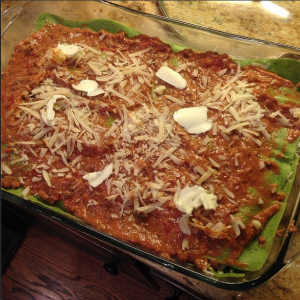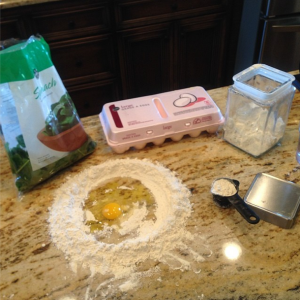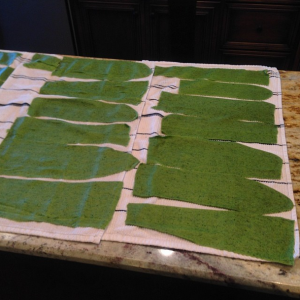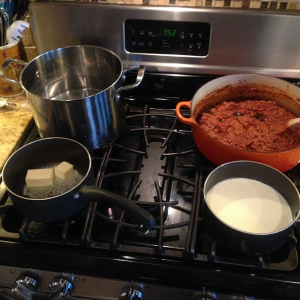 The recipe was originally written in otherwise unknown characters referred to as “reformed Italian” engraved on Versace plates. The last chef to contribute to the book, a transgender named Marcella Keller, buried it in a vineyard in present-day Italy, then returned to Napa, California in 1978 as an angel investor, who later revealed the details of the recipe to me, and instructed me to translate it into English for use in the encouragement of the true cult of food.
The recipe was originally written in otherwise unknown characters referred to as “reformed Italian” engraved on Versace plates. The last chef to contribute to the book, a transgender named Marcella Keller, buried it in a vineyard in present-day Italy, then returned to Napa, California in 1978 as an angel investor, who later revealed the details of the recipe to me, and instructed me to translate it into English for use in the encouragement of the true cult of food.
I was told the recipe book was to be called: The Book of Food: An Account Written by the Hand of Marcella Keller upon Plates Taken from the Plates of Versace.
Until now this recipe has been revealed by God only to me. It is inspired, inerrant, and infallible. Amen.
Heavenly Lasagna (allow four hours)
RAGÚ BOLOGNESE
First, the more marbled the meat, the sweeter the ragù. The most desirable cut of beef is the neck portion of the chuck. You may have to call up and order it from your butcher. It’s also important to salt the meat as soon as it hits the pan; it extracts the juices and flavors the sauce. Last, use a heavy pot that retains heat. (I use my treasured Le Creuset 5-quart Dutch oven.)
2 tablespoons vegetable oil
8 tablespoons unsalted butter
2/3 cup finely chopped onion
3/4 cup finely chopped celery
3/4 cup finely chopped carrot
1 lb. ground chuck
Kosher salt and freshly ground black pepper
1 cup whole milk
1/8 teaspoon freshly grated nutmeg
1 cup dry white wine
28 oz. canned imported Italian San Marzano tomatoes, crushed by hand, with their juice
2 tablespoons heavy cream
1 parmesan cheese rind
Freshly grated Parmigiano-Reggiano cheese, at the table
DIRECTIONS
1. Heat the oil and 6 tablespoons butter in a heavy 5-quart over medium heat until the butter melts and stops foaming. Drop in the onion and cook, stirring frequently, until it has become translucent, about 5 minutes.
2. Dump in the celery and carrot and cook for 2 minutes, stirring the vegetables to coat them well with the fat.
3. Add the ground meats, a very healthy pinch of salt, and a goodly amount of pepper. Crumble the meat with a wooden spoon, and stir well the meats have lost their raw, red color.
4. Turn the heat to low. Pour in the milk and simmer gently, stirring frequently, until it has burbled away completely, about 1 hour. Stir in the nutmeg.
5. Pour in the wine and let it simmer, stirring frequently, until it has evaporated, about 1 1/4 hours.
6. Add the crushed tomatoes, the parmesan cheese rind, and stir thoroughly to coat everything well. When the tomato puree begins to bubble, turn down the heat so that the sauce cooks at the laziest of simmers, with just an intermittent bubble breaking through the surface.
7. Cook, uncovered, for 3 hours or more, stirring from time to time. While the sauce is burbling away, there’s a chance that it’ll stat drying out somewhat, and the fat will separate from the meat.To keep it from sticking to the bottom of the pot and scorching, add 1/2 cup water as necessary. But it’s crucial that by the time the sauce has finished simmering, the water should be completely evaporated, and the fat should separate from the sauce. Season with salt and pepper to taste.
8. Add remaining 2 tablespoons heavy cream to the hot pasta and toss with the sauce.
PASTA DOUGH
8oz flour
6 ounces fresh chopped spinach, rinsed, dried thoroughly
6 egg yolks
1 whole egg
1 tbsp milk
1 tbsp olive oil

- On a clean and pure surface, mound the flour and make a well in the center.
- Add the spinach, egg yolks, egg, milk, and olive oil to the center of the well.
- Gently break up the eggs with your fingers.
- Begin turning the egg mixture in a circular motion with your fingers, gradually pulling in flour from the sides of the well. Continue mixing until all the flour has been incorporated and a sticky paste has formed. The mixture will thicken and eventually get too tight to keep turning with your fingers.
- Knead the dough by pressing it, bit by bit, in a forward motion with the heels of your hands rather than folding it over on itself as you would with a bread dough. Re-form the dough into a ball and repeat the process several times. The dough should feel moist but not sticky. Let the dough rest for a few minutes while you clean the work surface.Dust the clean work surface with a little flour. Knead the dough by pushing against it in a forward motion with the heels of your hands. Form the dough into a ball again and knead it again. Keep kneading in this forward motion until the dough becomes silky-smooth. The dough is ready when you can pull your finger through it and the dough wants to snap back into place. The kneading process can take anywhere from 10 to 15 minutes. Even if you think you are finished kneading, knead it for an extra ten minutes; you cannot overknead this dough.
- Double-wrap the dough in plastic wrap to ensure that it does not dry out. Let the dough rest for at least 30 minutes and up to 1 hour before rolling it through a pasta machine. The dough can be made a day ahead, wrapped and refrigerated; bring to room temperature before proceeding.
 7. Cut the ball of dough into 6 equal parts.
7. Cut the ball of dough into 6 equal parts.
8. Spread clean, dry, cloth dish towels over a work counter near where you’ll be using the machine.
9. Set the pair of smooth cylinders, the thinning rollers, at the widest opening. Flatten one of the pieces of dough by pummeling it with your palm, and run it through the machine. Fold the dough twice into a third of its length, and feed it by its narrow end through the machine once again. Repeat the operation 2 or 3 times, then lay the flattened strip of pasta over a towel on the counter. Since you are going to have a lot of strips, start at one end of the counter, leaving for for the others.
10. Take another piece of dough, flatten it with your hand, and urn it through the machine exactly as described above. Lay the strip next to the previously thinned one on the towel, but do not allow them to touch or overlap, because they are still moist enough to stick to each other. Proceed to flatten all the remaining pieces in the same manner.
11. Close down the opening between the machine’s rollers by one notch. Take the first pasta strip you had flattened and run it once through the rollers, feeding it by its narrow end. Do not fold it, but spread it flat on the cloth towel, and move on to the next pasta strip in the sequence.
12. When all the pasta strips have gone through the narrower opening once, bring the rollers closer together by another notch, and run the strips of pasta through them once again, following the procedure described above. You will find the strips becoming longer, as they get thinner, and if there is not enough room to spread them out on the counter, you can let them hang over the edge. Continue thinning the strips in sequence, progressively closing down the opening between the rollers one notch at a time. This step-by-step thinning procedure, which commercial makers of fresh pasta greatly abbreviate or skip altogether, is responsible, along with proper kneading, for giving good pasta its body and structure.
Make sure the strips are thin enough so that they are almost transparent.
 PUTTING IT ALL TOGETHER
PUTTING IT ALL TOGETHER
Bolognese Sauce
Béchamel Sauce
Green pasta dough
1 tablespoon salt
2 tablespoons butter, plus more for greasing a 9- by 12-inch bake-and-serve lasagna pan, no less than 2½ inches high
1 cup fresh grated parmigiano-reggiano cheese
1. Prepare the meat sauce and set aside.
2. Prepare the béchamel, keeping it rather runny, somewhat like sour cream. When done, keep it warm in the upper half of a double boiler, with the heat turned to very low. If a film should form on top, just stir it when you are ready to use it.
3. Make green pasta dough. Roll it out as thin as it will come. Leave the strips as wide as they come from the rollers, and cut them into 10-inch lengths.
4. Set a bowl of cold water near the range, and lay some clean, dry cloth towels flat on a work counter. Bring 4 quarts of water to a rapid boil, add 1 tablespoon salt, and as the water returns to a boil, slip in 4 or 5 of the cut pasta strips. Cook very briefly, just seconds after the water returns to a boil after you dropped in the pasta. Retrieve the strips with a colander scoop of slotted spatula, and plunge them into the bowl of cold water. Pick up the strips, one at a time, rinse them under cold running water, and rub them delicately, as though you were doing fine hand laundry. Squeeze each strip very gently in your hands, then spread if flat on the towel to dry. When all the pasta is cooked in the manner, 4 or 5 strips at a time, and spread out to dry, pat it dry on top with another towel.
*Explanatory note: The washing, wringing, and drying of pasta for lasagna is something of a nuisance, but it is necessary. You first dip the partly cooked pasta into cold water to stop the cooking instantly. This is important because if lasagna pasta is not kept very firm at this stage it will become horribly mushy later when it is baked. And you must afterward rinse off the moist starch on its surface, or the dough will become glued to the towel on which it is laid out to dry, and tear when you are ready to use it.
5. Preheat the oven to 400 degrees.
6. Thickly smear the bottom of a lasagna pan with butter and about 1 tablespoon of béchamel. Line the bottom of the pan with a single layer of pasta strips, cutting them to fit the pan, edge to edge, allowing no more than ¼ inch for overlapping.
7. Combine the meat sauce and the béchamel and spread a thin coating of it on the pasta. Sprinkle on some grated parmesan, then add another layer of pasta, cutting it to fit as you did before. Repeat the procedure of spreading the sauce and béchamel mixture, then sprinkling with Parmesan. Use the trimmings of pasta dough to fill in gaps, if necessary. Build up to at least 6 layers of pasta. Leave yourself enough sauce to spread very thinly over the topmost layer. Sprinkle with parmesan and dot with butter.
*Ahead-of-time note: The lasagna may be completed up to 2 days in advance up to this point. Refrigerate under tightly sealing plastic wrap.
8. Bake on the uppermost rack of the preheated oven until a light, golden crust formed on top. It should take between 10 and 15 minutes. If after the first few minutes you don’t see any sign of a crust beginning to form, turn up the oven another 50 to 75 degrees. Do not bake longer then 15 minutes altogether.
9. Remove from the oven and allow to settle for about 10 minutes, then serve at table directly from the pan.
You are what you eat. Amen and Amen!